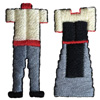 The tradition of wedding garments is one of the oldest most and respectful for every nation. Usually, national costume of the country plays the role of the wedding garment. But it is not always so. Nevertheless traditional wedding dress shows us the mentality and temper of a certain nation. Let's have a look at 10 most popular and extraordinary traditional wedding dresses. Different colors, fabric, design, decorations, and accessories make every traditional wedding attire unique.
The tradition of wedding garments is one of the oldest most and respectful for every nation. Usually, national costume of the country plays the role of the wedding garment. But it is not always so. Nevertheless traditional wedding dress shows us the mentality and temper of a certain nation. Let's have a look at 10 most popular and extraordinary traditional wedding dresses. Different colors, fabric, design, decorations, and accessories make every traditional wedding attire unique.
Read also:
Basic Hindu wedding traditions. Very special Indian wedding
Emirati wedding traditions. Mahleb spice
Amusing wedding traditions in Lebanon
Wedding traditions in the Philippines
Egyptian
There are 2 styles of traditional wedding dresses in Egypt: very rich, all in gold, and very pure, all in white.
Egyptian traditional wedding dress can be very ornated with gold, fabric has the color of gold. The dress is very long, with a train. All the jewelry is golden, including the headdress, which is crown-shaped or tiara-shaped. There is lots of embroidery on the fabric, lots of decorations and so on. Everything is made on the basis of golden motives. And there is a reason for it – ancient Egyptians considered that wife is a very respectful and wealthy person. The wedding is a great event for Egyptians, and they spend a huge amount of money to organize it.
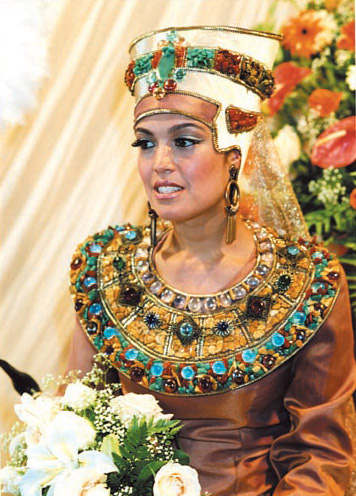
Egyptian traditional wedding dress. Photo by Theweddingspecialists.net
The other, alternative, traditional wedding dress in Egypt is white, very long, comfortable and elegant. Usually, golden jewelry is worn with a white gown, but there are not as many, as with the previous style of dressing. This style can be called "wealthy simplicity" because the dress is made of simple white fabric, but the quality and design of it are really great. Very often such white dresses are decorated with golden embroidery or elements on top and on the hem.
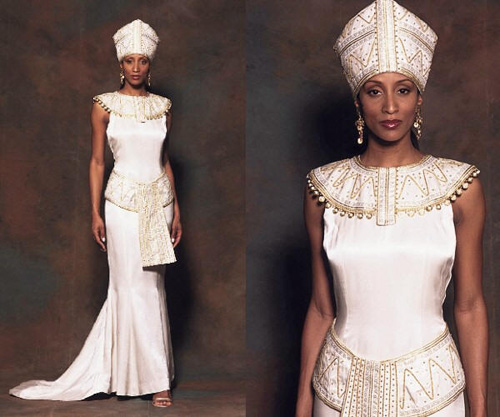
Egyptian traditional wedding dress. Photo by Therezfleetwoodbridal.com
In general, Egyptian traditional wedding dresses are usually made of natural linen, they are very long. The bride can use a lot of golden jewelry. The whole wedding garment must express lightness, warmth, and brightness.
Japanese
Traditional Japanese wedding dress is kimono, but specific kind of this Japanese national costume. The bride wears everything white, sometimes even paints her face white. White silk kimono, that is worn, may be of different design.
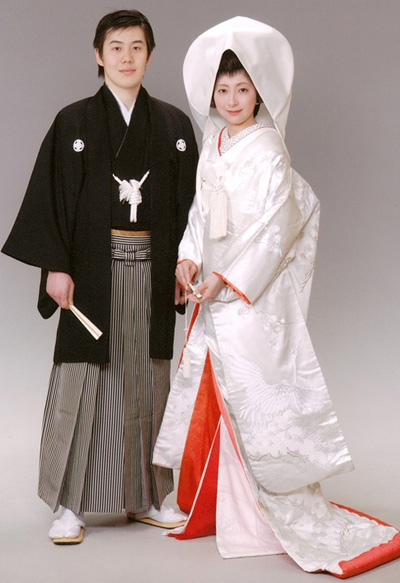
Traditional Japanese wedding dress. Photo by Weddingdesign.hu
The headdress plays an important role. It is white and wide. It may be a separate headdress or a hood. Often it is worn over a wig.
There are also other accessories for a Japanese bride: in her bosom, she has a small sword and small box with a hand mirror and comb. Sometimes a bride also has a golden or silver fan.
Share your own or your ancestors’ love story with the world!
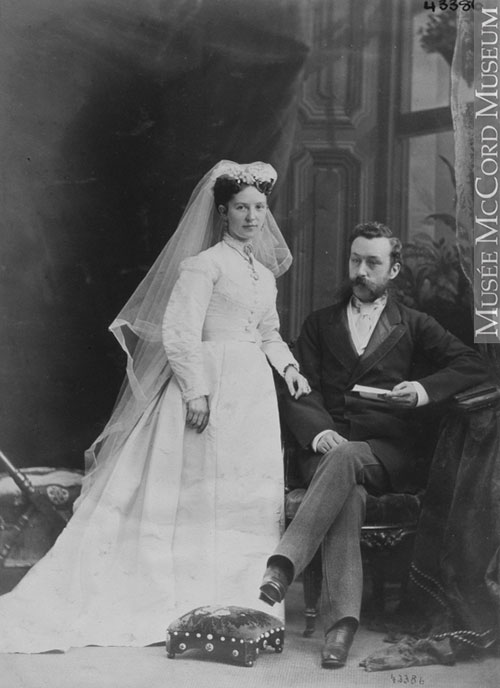
Our partner website Weddingsallovertheworld.com starts a new project where people can publish their own Wedding Story or – and that’s even more exciting! – the Wedding Story of their ancestors. If you know how your grandparents, great grandparents, or other relatives met and got married, don’t miss the chance to tell their story. Isn’t it romantic and adorable to read real-life love tales that happened dozens or even hundreds of years ago?!
You’ll find details here: Your Wedding Story
Indonesian
In Indonesia, every ethnic group has its own traditions in wedding garments. The most popular Indonesian traditional wedding dress consists of kebaya blouse and batik skirt or kebaya dress. Kebaya is a kind of cloth decorated with sequins all over. It looks very beautiful and festive. Usually, Indonesian wedding dresses are floor-long, with a tail. The material for it is always bright, richly decorated with embroidery, lace, jewels etc.

Indonesian traditional wedding dress. One of many
Muslim women also use kebaya dresses of brocade and lace, but they use lining inside the wedding dress to cover their skin.
Another tradition for Indonesian wedding dresses is a very beautiful, sophisticated and rich, but often very heavy, headdress. It is decorated with jewelry, gold, gems, and flowers.
Korean
Korean traditional wedding dress is a Hanbok, that is often called "Hollyebok". Actually, the wedding attire consists of a blouse or short jacket with long sleeves, a full skirt, a high waisted wrap around the skirt and a headdress.
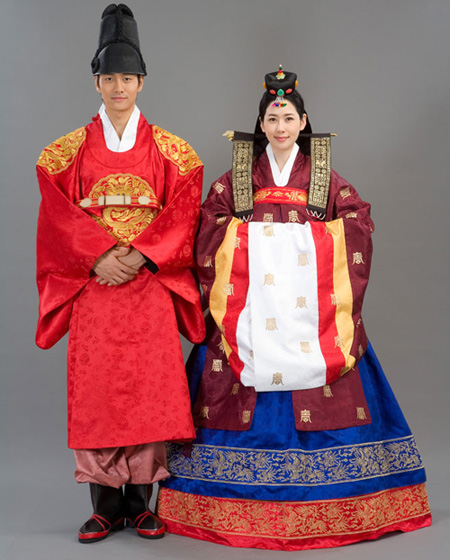
Korean traditional wedding dress
Korean wedding dress can be very colorful, not just white. Hanbok is often red, blue, pink or multi-colored. It is silk and richly embroidered. The wedding dress has very wide and colorful sleeves.
There is a special small headdress to finish the costume. Sometimes the headdress is big, with a lot of decorations. In other cases, bride wears a high hairdo with jewelry and decorations.
The style of Korean traditional wedding dress varies depending on the region. And not only colors and accessories vary, but mostly the headdresses.
Indian
Indian traditional wedding dress is, of course, a sari. Every region has its own traditions of sari wearing: color, pieces of a costume, style of draping sari, jewelry. But the common features are brightness, wealth and a great amount of jewelry. Sari is considered to be one of the most stunning and feminine clothing for a woman.
Indian women like jewelry very much, they wear it every day, but for the wedding, they choose the most expensive, large and bright jewelry. An Indian bride is all in gold and gems. And also Indian brides cover their skin (especially hands) with henna paintings.

Indian traditional wedding dress
Another rule for Indian weddings is bride should be wearing red, not a white dress. White is for funerals.
Traditional wedding dress in India often includes a bridal veil. Sometimes it covers only the face but may cover shoulders, back, and even waistline as well. On top of the head, a bride wears a crown or some jewelry to suit a veil.
Vietnamese
Traditional Vietnamese wedding dress is called Ao Dai. There are many various styles of Ao Dai, typical for different regions of the country. The dress is very feminine and graceful, tight-fitting, that repeats all the curves of the body. Usually, Ao Dai is red (but it can be of any bright color), long and richly embroidered with national patterns. The wedding dress can be made of silk, lace or chiffon. It has the form of tunic and often is worn over pantaloons made of matching fabric.
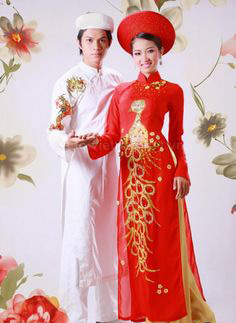
Vietnamese traditional wedding dress. Photo by Pinterest.com
There is also a specific headdress called "khan dong" that matches the wedding dress. It is a round hat that turns up instead of down and has an opening in the top. It circles the bride's face.
Turkish
Traditional Turkish wedding dress is very rich, made of expensive materials (like silk, velvet etc.), beautifully embroidered and decorated. Golden and silver threads were often used in the embroidery of wedding gowns.
Traditional Turkish wedding clothing may consist of baggy trousers or salvar, a blouse, a jacket, a robe called entari and kaftan. Traditionally an entari is worn over shalvar. Such wedding costume was used in Turkey until the 19th century.
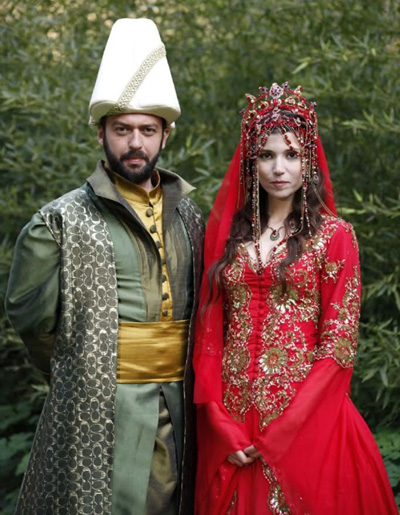
Traditional Turkish wedding dress. Photo by Pinterest.com
Another variation of Turkish wedding dress is called üç etek or dört etek. The main piece of such costume is a ground-long skirt divided into three and four sections. It is open down the front and fastened by several buttons at the waist. This version of wedding dress was popular in Turkey in the 19th century.
Also, Turkish women wore bindalli dresses in the 19th century. They were made of purple or dark red velvet with embroidery and goldwork. Very beautiful and rich.
In general traditional Turkish wedding dresses always were modest, closed and consisted of several pieces. The headdress was obligatory and looked like a fez or a kerchief. Dresses and skirts were long. Everything was ornate and beautiful.
Thai
Thailand traditional wedding dress is very elegant and beautiful. But it is rather simple also. Usually, Thai women don't buy a wedding dress just for one time to wear, they use it after the wedding as an evening dress. Actually, there is no specified wedding dress in Thailand, brides just use Thai national costume.
Traditional Thai wedding dress is made of cotton and silk, no synthetic. The wedding dress itself is a close-fitting, brightly colored ensemble, often ornated with gold and gemstones. Golden jewelry is used to complement the costume.
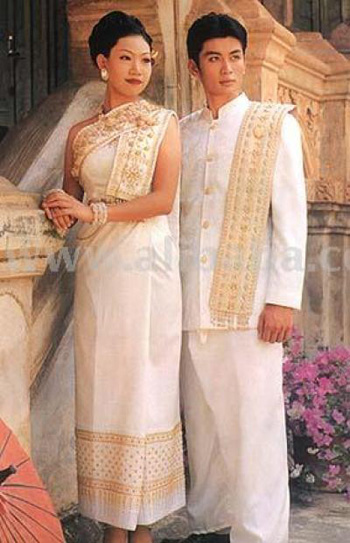
Thailand traditional wedding dress
Thai wedding dress may consist of a full-length wrap-around sarong with two pleated folds, and a one-shouldered sleeveless top made of lace or heavily pleated silk, topped with an optional over-the-shoulder, floor-length shawl. Another variant consist of a rounded neck, and long sleeved blouse, either buttoned at the front or the back; the top is tucked beneath a floor length skirt with two front pleats.
Chinese
Chinese traditional wedding dress is very bright and sunny. It is always red or red&white. Also, there are a lot of golden and silver embroidery (very often phoenix and dragon are embroidered on bride's and groom's clothing). The wedding dress may consist of 1 or 2 pieces. The top of it is tight-fitted; the bottom is either straight or wide. And the wedding dress in China is always long.
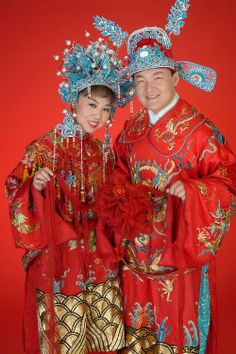
Chinese traditional wedding dress
There is a special headdress for a bride. It looks like a tiara, but decorated with feathers, pearls, golden or silver elements – it represents the phoenix. Sometimes this headdress is rather heavy.
In the old days, there was a tradition to cover the bride's head with a red veil. Bride and groom weren't supposed to see each other's face until the wedding night. But this tradition has passed away. Such veil is used very seldom today.
Mongolian
Traditional Mongolian wedding dress consists of a bright and rich tunic and a beautifully ornated headdress. The tunic is called "deel" and can be made of cotton, silk or other materials, but it must be bright and colored. Usually, the deel is red, with a lot of embroidery, jewelry, and patterns on fabric.
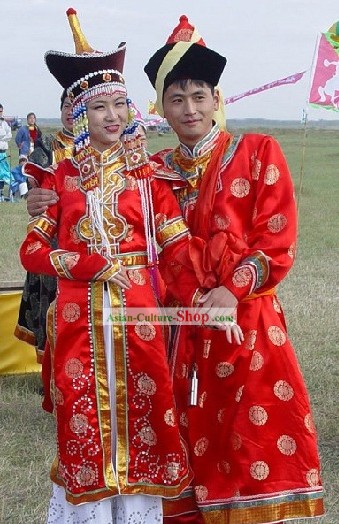
Traditional Mongolian wedding dress. Photo by Asian-culture-shop.com
The headdress is round, flat and big. The more decorations it has, the better. This headdress shows the wealth of the bride. So, it is also ornated: with embroidery, jewelry, fur, and other decorations.
